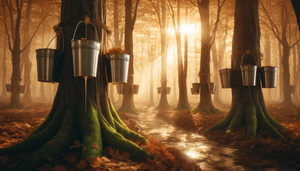Impact on Syrup Quality and Grades
Jul 23, 2024
Maple syrup is more than just a sweet addition to breakfast tables; it is a cherished tradition, a symbol of artisanal quality, and a representation of sustainable, locally-sourced goodness. However, changing climate conditions are beginning to alter the landscape of maple syrup production, impacting both its quality and grades. In this post, we explore how these environmental shifts are affecting this beloved product and what it means for maple syrup lovers, foodies, and culinary enthusiasts.
The Tradition of Maple Syrup Production
Maple syrup production is a time-honored tradition, especially in regions like Vermont, where generations of families have perfected the art. This process depends heavily on specific climate conditions: cold nights and warm days that create the ideal environment for sap flow. Traditionally, these conditions occur from late winter to early spring.
Changing Climate Conditions
In recent years, climate change has introduced unpredictable weather patterns, disrupting the delicate balance needed for optimal sap production. Here’s how these changes are impacting maple syrup quality and grades:
- Shorter Sap Seasons
- Warmer temperatures can cause the sap season to start earlier and end sooner, reducing the amount of sap collected.
- Inconsistent temperatures can lead to a shortened season, impacting syrup yield.
- Sap Sugar Content
- Ideal conditions for high-sugar sap include a freeze-thaw cycle. Warmer winters with fewer freeze-thaw cycles result in sap with lower sugar content, requiring more sap to produce the same amount of syrup.
- This can increase production costs and impact the flavor profile.
- Flavor Changes
- The unique, rich flavor of maple syrup is influenced by the specific conditions in which the sap is harvested. Variations in weather can alter these flavors, leading to less consistency and potentially lower grades of syrup.
- Maple syrup grades are determined by color and flavor, ranging from the light, delicate Grade A Golden to the robust, darker Grade A Very Dark.
- Forest Health
- Maple trees themselves are affected by climate change. Increased susceptibility to pests, diseases, and other stressors can reduce tree health and sap production.
- This not only impacts the quantity of syrup produced but also the quality, as unhealthy trees produce lower-quality sap.
Impact on Maple Syrup Grades
Maple syrup is graded based on its color and flavor, which are direct indicators of quality. Climate change can influence these aspects in various ways:
- Grade A Golden: Lightest in color with a delicate flavor, typically produced early in the season. Warmer temperatures can shorten this period, reducing the availability of Grade A Golden syrup.
- Grade A Amber: Richer in flavor, produced as the season progresses. Inconsistent temperatures can affect its production, leading to fluctuations in availability and quality.
- Grade A Dark: Darker and more robust, produced later in the season. Warmer, shorter seasons can reduce the volume of this grade.
- Grade A Very Dark: The darkest and most robust, used mainly for cooking. Changes in climate can lead to an overabundance of this grade, as sap harvested later in the season tends to produce darker syrup.
Sustainability and the Future of Maple Syrup
Producers are adapting to these changes by implementing sustainable practices and advanced technologies to mitigate the impact of climate change. These include:
- Forest Management: Maintaining healthy maple forests through sustainable forestry practices to ensure long-term sap production.
- Technological Innovations: Using vacuum tubing systems and reverse osmosis to improve sap collection efficiency and sugar concentration.
- Climate Research: Collaborating with scientists to understand climate trends and develop strategies to adapt to changing conditions.
Conclusion
As climate change continues to affect maple syrup production, understanding its impact on syrup quality and grades becomes crucial for producers and consumers alike. By supporting sustainable practices and appreciating the traditional methods of maple syrup production, we can help preserve this beloved tradition for future generations.
Frequently Asked Questions (FAQs)
Q: How does climate change affect the taste of maple syrup? A: Climate change can alter the sap collection season and sugar content, impacting the flavor and consistency of maple syrup.
Q: What are the different grades of maple syrup? A: Maple syrup is graded based on color and flavor, including Grade A Golden, Amber, Dark, and Very Dark.
Q: How are producers adapting to climate change? A: Producers are using sustainable forestry practices, advanced technologies, and collaborating with climate scientists to adapt to changing conditions.
Q: Is maple syrup production sustainable? A: Yes, many producers focus on sustainable practices to ensure the long-term health of maple forests and syrup production.


